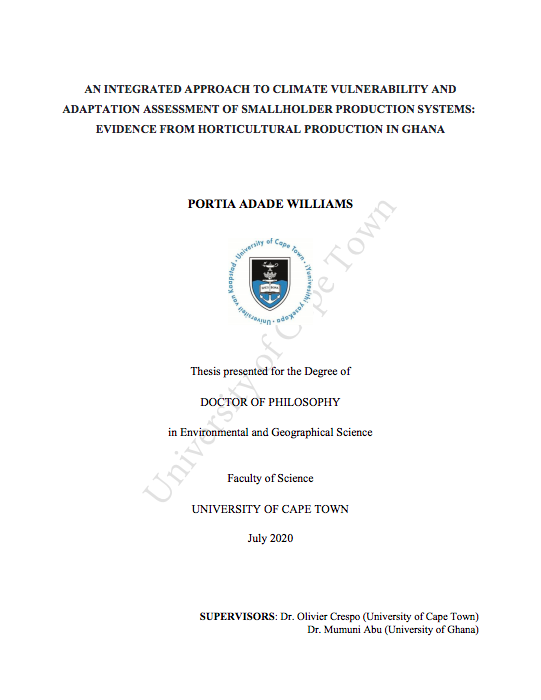Back to Library
An integrated approach to climate vulnerability and adaptation assessment of smallholder production systems: evidence from horticultural production in Ghana

Published by:
Document
Download
Online Location
https://open.uct.ac.za/handle/11427/32359
Publication date
07/11/2020
Number of Pages
251
Language:
English
Type of Publication:
Studies
Focus Region:
Sub-Saharan Africa
Focus Topic:
Climate / Weather / Environment
Type of Risk:
Weather & Climate related
Type of Risk Managment Option:
Risk coping
Commodity:
Crops
Author
Portia Adade Williams
Organization
University of Cape Town
ABSTRACT
The consequences of changing climate mainly impact negatively on agricultural production, particularly smallholder producers. Despite increased research on vulnerability and adaptation, African countries have still not realized their full potential in adapting to changing climate. Climate vulnerability assessments show limited use in guiding decision support for adopting proposed adaptation responses identified. This study examines climate vulnerability of smallholder producers and economically evaluates adaptation strategies identified. This is to enhance vulnerability assessment practice and provide support for decision-making on adoption to influence local level planning and actions on climate adaptation. The study further explores approaches to vulnerability assessment that link climate adaptation process. Smallholder horticultural production system in Ghana provided an appropriate case for this study. Mixed methods approach that combined field surveys, in-depth interviews, focus group discussions and field observations in two horticultural growing municipalities in Ghana (Keta and Nsawam) were adopted. Both qualitative and quantitative inputs for analysis were obtained. Specifically, a combination of theoretical insights from livelihood analysis (Livelihood Vulnerability Index) with an appraisal method (Cost-Benefit Analysis) arising from an investment in adaptation options was used as the analytical framework for the study. Smallholder farmers in both case study sites showed different vulnerabilities based on their levels of exposure, sensitivity and adaptive capacity. Local knowledge, perceptions and effects of climatic trends (eg. increasing temperature and decreasing rainfall) on farmers’ livelihoods resulted in identification of about twenty-four strategies practiced by farmers to manage changing climate. Costs and benefits analysis of the first five adaptation strategies indicated economic effectiveness both privately and publicly if adopted. However, in consideration of other factors like capital required, payback period for investments made and risks from implementation, two of the adaptation strategies particularly appeared as most suited choices while the role of targeted and dedicated external institutional, policy and stakeholders’ support turned out to be paramount for successful adaptation. These observations have implications for the degree of influence vulnerability assessment has for local level planning and actions on climate adaptation. The study underscores vulnerability and adaptation should be considered synergistically. It therefore proposes a framing of vulnerability assessment to explicitly incorporate adaptation actions and their benefits to reduce vulnerability and provide better linkages to decision-making and policy relevance. Making decision support a major outcome from vulnerability assessment extends assessment outcomes from identification of vulnerable people/places to include identification and evaluation of adaptation responses, which facilitate the prioritization and selection of adaptation options for adoption. It concludes by highlighting pathways to reduce the vulnerability of farming communities such as exploring opportunities to expand a system’s adaptive capacity through empowering farmers’ socially and economically. Extra knowledge and policy interventions in vulnerability and adaptation discourse are further suggested to promote and encourage adaptation efforts.